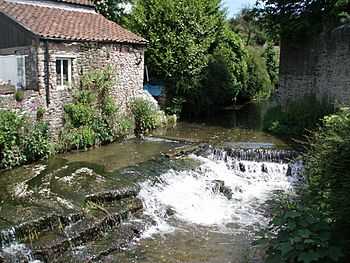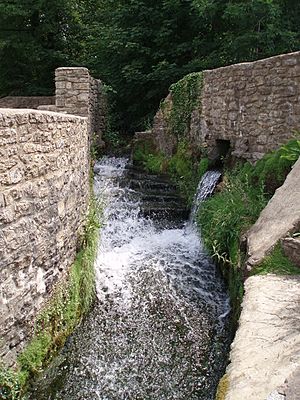River Sheppey facts for kids
Quick facts for kids River Sheppey |
|
|---|---|

River Sheppey at Croscombe
|
|
| Country | England |
| County | Somerset |
| City | Shepton Mallet |
| Physical characteristics | |
| Main source | St Aldhelm's Well Doulting, Mendip, Somerset, England 51°11′13″N 2°30′31″W / 51.18694°N 2.50861°W |
| River mouth | River Brue near Westhay, Mendip District, Somerset, England 51°10′44″N 2°47′41″W / 51.17889°N 2.79472°W |
The River Sheppey is a river in Somerset, England. It starts from a group of natural springs, which are places where water flows out of the ground. These springs are found west of the village of Doulting, close to Shepton Mallet. The river then flows through wet, marshy areas north of the Polden Hills. Finally, it joins another river called the River Brue.
Contents
Where does the River Sheppey flow?
The River Sheppey begins its journey in Doulting. From there, it flows southwest towards a place called Charlton. In some parts of Charlton, the river flows underground through pipes or tunnels. This is called being culverted.
Sheppey's journey through towns
The river goes underground for most of its path through Shepton Mallet. It then comes back to the surface at Darshill. After that, it continues southwest through Croscombe and then to Dinder. At Dinder, the river flows through the beautiful grounds of Dinder House. There's even an old bridge there that is older than the house itself!
The Sheppey then flows west past villages like Dulcote, Woodford, and Coxley. At Coxley, a smaller stream called the Keward Brook joins the Sheppey. This brook carries water from the springs in Wells. These springs are famous because they fill the moat around the Bishop's Palace.
Sheppey's journey to the River Brue
From Coxley, the river turns north and flows through areas known as Hay Moor and North Moor. It then goes west through Ash Moor. After that, it turns sharply south through Frogmore and then west through Godney.
At Lower Godney, where there's a pub named after the river, the Sheppey's water is directed into special channels. These channels are called the James Wear River and the Decoy Rhine. They lead the water to Westhay Level. Here, the Sheppey joins Whites River and then finally flows into the River Brue, near Westhay.
What about the River Sheppey's water quality?
Generally, the water in the River Sheppey is quite good. However, sometimes water from sewage treatment plants can flow into the river. This can add extra nutrients to the water. When the river's flow is low, you might notice signs of these extra nutrients. This can sometimes affect the plants and animals living in the upper parts of the Sheppey.
How has the River Sheppey been used in the past?
It seems that people only started calling this river the "Sheppey" in the late 1800s. Before that, it might have been known as Doulting Water or even the River Brae.
The River Sheppey was very important for local businesses a long time ago. Its flowing water was used to power mills. These mills helped grind corn into flour and make textiles (cloth) in the Shepton Mallet area. There might have been more than 30 mills powered by the Sheppey and its smaller streams around Shepton Mallet, Bowlish, and Darshill!


